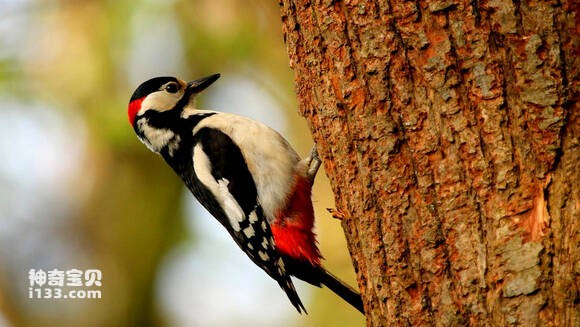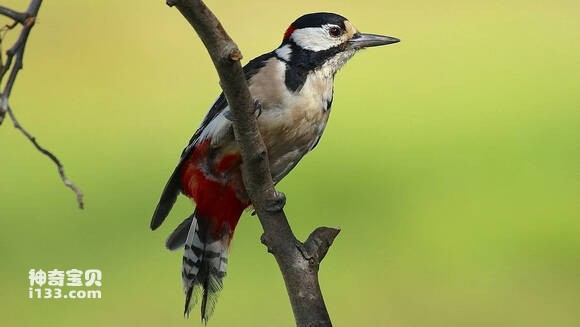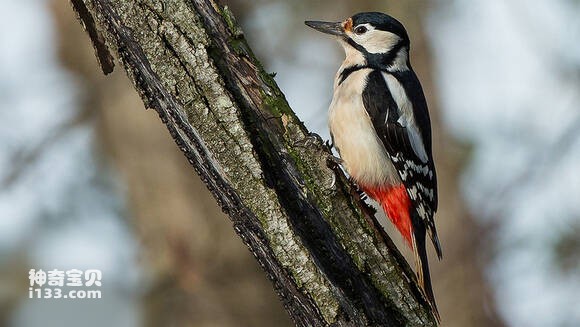Dendrocopos major
IUCN
LCBasic Information
Scientific classification
- name:Dendrocopos major
- Scientific Name:Dendrocopos major,Great spotted woodpecker
- Outline:Climbing birds
- Family:
Vital signs
- length:22-25cm
- Weight:62-79g
- lifetime:No textual research information is available
Feature
Distribution and Habitat
The species is found in Albania, Algeria, Andorra Republic, Armenia, Austria, Azerbaijan, Belarus, Belgium, Bosnia and Herzegovina, Bulgaria, China, Croatia, Czech Republic, Denmark, Estonia, Finland, France, Georgia, USA, Germany, Greece, Hungary, India, Iran Republic of Korea, Italy, Japan, Kazakhstan, Democratic People's Republic of Korea, Korea, Kyrgyzstan, Lao People's Democratic Republic, Latvia, Liechtenstein, Lithuania, the Principality of Luxembourg, Macedonia, Moldova, Mongolia, Montenegro, Morocco, Myanmar, Netherlands, Norway, Poland, Portugal, Romania, Russia, Serbia Slovakia, Slovenia, Spain, Sweden, Switzerland, Tunisia, Turkey, Ukraine, United Kingdom, United States, Vietnam.
Travellers: Faroe Islands, Gibraltar, Iceland, Ireland, USA.
The species is found in Xinjiang, northeastern Inner Mongolia, Heilongjiang, Jilin, Liaoning, Hebei, Henan, Shandong, Jiangsu, Anhui, Shanxi, Shaanxi, Gansu, Qinghai, Sichuan, Guizhou, Yunnan, Hubei, Hunan, Jiangxi, Zhejia
Appearance
The male has a brown-white forehead, white eyes, eyebrows, cheeks, and ear feathers. The top of the head is black with blue luster. The pillow has a bright red spot, and the hind pillow has a narrow black transverse band. The back and sides of the neck are white, forming a white collar. Shoulder white, back bright black, waist dark brown with white end spots; The two wings are black, the wing edge is white, and the flying feathers have square or nearly square white patches, and the inner wings cover the feathers and the large cover feathers are white, forming a nearly round large white spot on the inside of the wings. Central tail feathers black brown, lateral tail feathers white with black stripes. The zygomatic veins are broad and black, and are divided backward into upper and lower branches, the upper branch extending behind the head, and the other one extending downward to the chest side. Chin, throat, front neck to chest and two sides stained white, abdomen is also stained white,
Details
Dendrocopos major, also known as the Great spotted woodpecker, has 14 subspecies。

Peckers feed mainly on beetles, silverfish, locusts, gilding beetles, longiceps larvae, ants, mosquitoes, wasp families, lepidoptera, Coleoptera and other insects and insect larvae. They also eat snails, spiders and other small invertebrates, and occasionally eat acorns, pine nuts, plum and grass seeds and other plant foods。

Woodpeckers often live alone or in pairs, and in loose family groups in late breeding. They feed on tree trunks and thick branches. Foraging often jumps up from the middle and lower part of the tree, such as finding insects in the bark or trunk, quickly pecks the wood to eat, using the tongue to poke into the bark or from the hole in the tree to hook pests. If you find someone when pecking, you hide behind the pecked wood or continue to climb, search a tree and then fly to another tree, when the two wings open and close, into a big wave forward, sometimes also on the ground between the trees and branches and leaves to eat. Cry 'jen-jen-'。

The breeding season of the Great spotted woodpecker is April to May. At the end of March, he began to estrus, during which he often struck the tree trunk violently with his mouth, issuing a 'Gong Gong... 'continuous sound, used to lure the opposite sex. Sometimes three birds (two males and one female) are also seen fighting together for a couple, stirring each other up and down, flying and calling until the other male is driven away. Nest in the tree hole, the nest hole is mostly chosen in the heart has decayed broad-leaved tree trunk, sometimes also in the thick side branches. It's made by both male and female birds. New holes every year, not old nests. Each nest hole takes about 15 days to complete. The height of the nest hole from the ground is mostly 4-8 meters, sometimes as high as more than 10 meters and as low as 2 meters. The hole is round, the diameter is 4.5-4.6 cm, the inner diameter of the hole is 8.5-10 cm, and the depth of the hole is 18-28 cm. There are no upholstery inside the nest, only a few wood chips. Three to eight eggs are laid in each litter, with a majority of four to six. Oval white, oval, smooth without spots, 24-27 mm x 16-21 mm in size. The male and female incubate the eggs in turn, and the incubation period is 13-16 days. The chicks are late sex, and the whole body is naked and featherless after hatching, and the flesh is red. Both male and female birds raise chicks together, and after 20-23 days of feeding, the chicks can leave the nest and fly。

Li Guohong et al. found that when the population density of Macropicus macropicus was about 0.37-0.55 ·hm⁻², the average pecking rate of the overwintering larvae of mulberry longiceps could reach 24.71%, which greatly inhibited the population density of mulberry longiceps. Zhu Yuanlong et al. investigated the natural control effect of woodpeckers in poplar forest on Maculatus maculatus, and found that both black-occipital green woodpecker and macromaculatus are the dominant natural predators of maculatus maculatus, which can effectively inhibit the population density of maculatus maculatus and achieve a good control effect of "no disaster caused by insects". Li Gang et al. investigated the control effect of the large spotted woodpecker on the plateauropterus, and found that a single woodpecker could pick 23 larva per day on average, and the average pecking rate of the plateauropterus was 72.3%. The use of the big-spotted woodpecker for pest control is rarely reported in other countries. Kobayashi found that under the condition of low insect population density of the pine Longicorn, the big-spotted woodpecker can play an important role in inhibiting the insect population.
It was included in the List of Beneficial Terrestrial Wildlife under State Protection or of Important economic and scientific research Value issued by the State Forestry Administration of China on August 1, 2000.
Listed on the International Union for Conservation of Nature (IUCN) 2012 Red List of Threatened Species ver 3.1 - Not Threatened (LC).








